Readings Newsletter
Become a Readings Member to make your shopping experience even easier.
Sign in or sign up for free!
You’re not far away from qualifying for FREE standard shipping within Australia
You’ve qualified for FREE standard shipping within Australia
The cart is loading…






Few regions possess so many and mainly complete Roman bridles as do the Vesuvian sites. Singular find conditions permit both comprehensive antiquarian-historian analyses of their production, functionality, and everyday use and new approaches to their typology and chronology. The 103 catalogued specimens belong to four types of bronze headstalls, namely metallic noseband, bitless metal bridle ( hackamore ), multipartite metallic bridle ( metallic halter ), and muzzle as well as two types of bits, namely snaffle bit with circular cheekpieces and curb bit. All of them occurred in more or less numerous variants of local or provincial origin. Special attention is paid to the reconstruction of application methods and combinations of types as well as the replica of a snaffle bit with circular cheekpieces. Bitless metal bridles followed Greek models, multipartite metallic bridles Celtiberian ones and, in combination with Thracian or Italian curb bits, formed typical military bridles. All Campanian finds came from civilian contexts such as luxury villae, villae rusticae, urban houses, and workshops. Thanks to find circumstances they can be attributed to draught animals, beasts of burden or mounts (horse, donkey, mule) which also showed up in stables and skeletal remains.
$9.00 standard shipping within Australia
FREE standard shipping within Australia for orders over $100.00
Express & International shipping calculated at checkout
Few regions possess so many and mainly complete Roman bridles as do the Vesuvian sites. Singular find conditions permit both comprehensive antiquarian-historian analyses of their production, functionality, and everyday use and new approaches to their typology and chronology. The 103 catalogued specimens belong to four types of bronze headstalls, namely metallic noseband, bitless metal bridle ( hackamore ), multipartite metallic bridle ( metallic halter ), and muzzle as well as two types of bits, namely snaffle bit with circular cheekpieces and curb bit. All of them occurred in more or less numerous variants of local or provincial origin. Special attention is paid to the reconstruction of application methods and combinations of types as well as the replica of a snaffle bit with circular cheekpieces. Bitless metal bridles followed Greek models, multipartite metallic bridles Celtiberian ones and, in combination with Thracian or Italian curb bits, formed typical military bridles. All Campanian finds came from civilian contexts such as luxury villae, villae rusticae, urban houses, and workshops. Thanks to find circumstances they can be attributed to draught animals, beasts of burden or mounts (horse, donkey, mule) which also showed up in stables and skeletal remains.